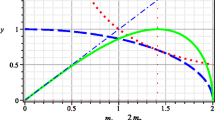Abstract
We are dealing with the Dirac Hamiltonian H = H0 + V with no magnetic field and radially symmetric electrostatic potential V = V(r), preferably the Coulomb potential. While the observable H is precisely predictable, its components H0 (relativistic mass) and V (potential energy) are not. However they both possess precisely predictable approximations H0 ∼ and V∼ which approximate accurately if the particle is not near its nucleus. On the other hand, near 0, H0 and V are practically unpredictable, perhaps in agreement with the fact, that a neutrino also should be in the game. [We have not yet studied the corresponding observables for the (≥ 12-dimensional) problem of electro-weak interaction.] Mathematically we are focusing on the spectral theory of the unbounded self-adjoint operators H0 ∼ and V ∼. We can prove that V ∼ is unitarily equivalent to V(r) again, by a unitary map given as Wiener-Hopf-type singular integral operator in the standard separation of variables for radially symmetric Dirac Hamiltonians. [This is, as far as the continuous spectrum is concerned.] Very similar unitary equivalence holds for H 0 ∼ and H 0. We are tempted to regard this as a form of “renormalization”.
Similar content being viewed by others
REFERENCES
J. v. Neuman, Die Mathematischen Grundlagen der Quantenmechanik (Springer, New York, 1932; reprinted: Dover 1943; English trsl, Princeton University press, 1955).
D. Dieks and P. Vermaas, The Modal Interpretation of Quantum Mechanics (Kluwer Academic, Dordrecht, 1998).
H. O. Cordes, “On pseudodifferential operators and smoothness of special Lie group representations,” Manuscripta Math. 28, 51–69 (1979).
H. O. Cordes, Proc. Inst. Math. NAS Ukraine, 50, 671–676 (2003).
H. O. Cordes, “A pseudo-algebra of observables for the Dirac equation,” Manuscripta Math. 45, 77–105 (1983).
H. O. Cordes, The Technique of Pseudodifferential Operators (London Math. Soc. Lecture Notes 202, University Press, Cambridge, 1995).
H. O. Cordes, “A precise pseudodifferential Foldy-Wouthuysen transform for the Dirac equation,” J. Evolution Equations 4, 125–138 (2004).
T. Kato, Perturbation Theory for Linear Operators (Springer, NewYork, 1966).
W. Magnus, F. Oberhettinger, and R. P. Soni, Formulas and Theorems for the Special Functions of Mathematical Physics, 3rd edn. (Springer, New York, 1966).
W. Magnus and F. Oberhettinger, Formeln und Saetze fuer die Speziellen Funktionen der Mathematischen Physik, 2nd edn. (Springer, Berlin, 1948).
I. Gohberg and N. Krupnik, Einfuehrung in die Theorie der Eindimensionalen Singulaeren Integraloperatoren (Birkhaeuser, Basel, 1979).
H. O. Cordes, “Pseudo-differential operators on the halfline,” J.Math.Mech. 18, 893–908 (1969).
E. A. Coddington and N. Levinson, Theory of Ordinary Differential Equations (McGraw-Hill, New York, 1955).
E. L. Ince, Ordinary Differential Equations (Dover, NewYork, 1956).
J. Horn, Gewoehnliche Differentialgleichungen (De Gruyter, Berlin, 1948).
E. Kamke, Differentialgleichungen, Loesungsmethoden und Loesungen (Chelsea, New York, 1966).
M. A. Naimark, Linear Differential Operators II (Ungar, New York, 1968).
H. Kittler, “Das Verhalten der bei x = +∞ normierten Loesungen von–u″ + V (x)u = k 2u in ihrer Abhaengigkeit von k,” Ph.D.-thesis (Goettingen, ≈ 1952).
G. H. Hardy, J. E. Littlewood, and G. Polya, Inequalities (CUP, Cambridge, 1934).
H. O. Cordes, “A pseudodifferential Foldy-Wouthuysen transform,” Communications in PDE 8(13), 1475–1485 (1983).
H. O. Cordes, “On Dirac observables,” Progress in Nonlinear DE 42, 61–77 (Birkhaeuser, Basel, 2000).
H. O. Cordes, “Dirac algebra and Foldy-Wouthuysen transform,” Evolution Equations and Their Applications , Lumer-Weis, ed. (Marcel Dekker, NewYork, 2000).
E. deVries, “Foldy-Wouthuysen transformations and related problems,” Fortschr. D. Phys. 18, 149–182 (1970).
B. Thaller, The Dirac Equation (Springer, New York, 1992).
Author information
Authors and Affiliations
Rights and permissions
About this article
Cite this article
Cordes, H.O. The Split of the Dirac Hamiltonian into Precisely Predictable Energy Components. Foundations of Physics 34, 1117–1153 (2004). https://doi.org/10.1023/B:FOOP.0000041287.25713.fe
Issue Date:
DOI: https://doi.org/10.1023/B:FOOP.0000041287.25713.fe



